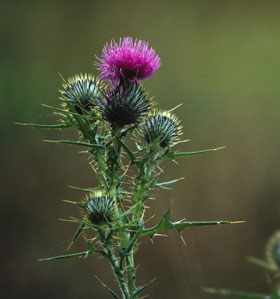
Copyright © Noella Ballenger
Soft light on an overcast day brings out the rich color in the thistle. By using a very long telephoto lens (400mm), isolating one thistle and keeping my depth of field restricted by using an F4, I was able to blur a very busy background and make the one thistle look exciting.
<style=”font-size: 10.0pt; font-family: Georgia”>
You’ve decided to photograph flowers, but how do you portray them in a way that will keep the viewers attention—show that creative wow factor that you saw and felt when you clicked the shutter button?
I’ve always felt that it is important to feel comfortable with a chosen subject and to have a general plan before I just grab my camera and run out the door. So when I approach flower photography, I like to not only do a bit of research on the subject, but ask myself some questions: What is it that I want to accomplish? What is it that I would like the viewer to see and feel? What shots am I seeing in my minds eye? And keep in mind, these are general questions—when you arrive at you destination, try to keep an open mind to what you might find. Sometimes the unexpected becomes a wonderful treasure.
So let’s think together about what makes an intriguing and wonderful flower photograph. A great place to start your research is to view other photo artists or painters work. How have they depicted the subject? I don’t want to duplicate their work or take their ideas, but I want to get a new perspective on the subject and what I think they wanted me to see. Their inspiring works of art can be a great stepping stone to your own creative ideas.
When it comes to flowers, I don’t think any painter says it better than Georgia O’Keefe. This fabulous abstract artist captured the subject brilliantly. For examples of some of her work, visit this web site.
Let me give you a few quotes from Georgia O’Keefe.
“Everyone has many associations with a flower – the idea of flowers. You put out your hand to touch the flower – lean forward to smell it – maybe touch it with your lips almost without thinking – or give it to someone to please them. Still – in a way – nobody sees a flower – really – it is so small – we haven’t time – and to see takes time like to have a friend takes time.”
Then later, “When you take a flower in your hand and really look at it,” she said cupping her hand and holding it close to her face, “it’s your world for the moment. I want to give that world to someone else… I want them to see it whether they want to or not.”
So she took the small flowers and painted them gigantically and showed the world an everyday subject in a way they had never been seen before. She took command and decided that they would see it her way, “…whether they wanted to or not”!
What did she do that we perhaps should consider doing with our photographic endeavors when we go into the garden or desert? How do we find our own way, as she did, to share the sights that can be found in the botanical world?
I think when I study O’Keefe, the overwhelming feeling I get is one of sharing the intimacy of the moment – of the view – with her. Then I feel the impact of her passion about her subject, about her art and about her life. WOW, those big thoughts!
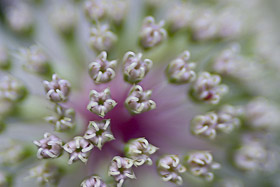
Copyright © Noella Ballenger
It was a very warm day in Canada when I saw this little bush covered in these flowers. It was in a shady spot so I just sat down to keep it company. The flowers are about the size of a quarter. They looked pretty and fresh and there were so many than from just one spot, I could take a variety of views.
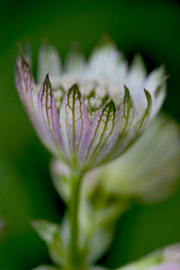
Copyright © Noella Ballenger
You don’t know a flower until you explore it from all angles.
Intimacy and Passion
What will allow us to get the sense of intimacy and passion into our botanical imaging? Does it mean always getting close to the subject … not necessarily, but it does mean taking away everything and anything that doesn’t contribute to the view you want to share. And it is in the act of sharing that there is an intimate bond formed between the viewer and the creator. When you can get the viewer to say, “Wow, I never saw the flower that way before!”, then you know that you have made that intimate connection. You have allowed them the freedom to enter your world and share your vision and that is about as intimate as you can get.
Passion comes about by caring deeply for what you are doing, or in this case, your subject being photographed. Many people treat passion rather cavalierly in that they become too casual, too blasé. Let me tell you a little story about a meeting I attended to listen to an outstanding professional photographer talk about his stunning photographs. Afterward his presentation, I saw and overheard a young man come up to him with a small portfolio of his work and he asked the speaker to critique it for him. You could see that he had to draw on all of his courage to approach this professional, but he couldn’t muster the energy to believe in his own body of work… flipping through it and offering excuses. This disparaging of his own work, diminishing his passion by his behavior and body language left an indelible impression on me. And, this isn’t the only time that I have seen this. In over twenty years of teaching photography, I have been approached any number of times and each time that it happens, I try to emulate that wonderful pro. He slowed the young photographer down, began a discussion and critique of just one image (how to improve or make it stronger), and pushed him into revealing his passion for the subject of his own work.
If you have the passion, explore it, photograph it and then share it with others with that same passion—claim it with pride.
So having said that… You have come to your chosen destination to find the flowers that spark your photographic creativity. Let’s see if some of the following questions will help you find a way to begin–to push you into showing your passion and into creating the intimate connection between yourself, your subject and your viewer.
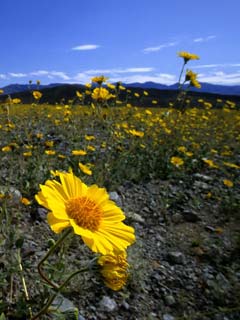
Copyright © Noella Ballenger
Using a wide angle lens very close to a flower will emphasize the flower while still allowing you to see the flower’s environment. It is important to know each lens you use and know how close you can be to the subject and still have it in focus. Try using a tape measure to actually check that distance. It will really get it fixed in your mind.
First, what seems to be attracting my attention? Why was I attracted to this particular spot or to this one flower? Is it the field of flowers, one little clump or a single blossom? It is critically important that you stop right now. This is the place to begin your exploration. Don’t wander away, but settle for a couple of minutes. Stop and look … really look at what you are seeing. Try to identify what made you stop and take that first look. Was it the color, the light, the aroma, the shape … can you put it into words? Are you seeing the vision that you have in your mind or, because you are now physically at your location, has a new vision replaced it? Maybe it’s both—maybe your vision has now expanded to new creative heights you didn’t think possible.
Sit with it, work with it, try to capture it…take an initial shot. Begin to work with a variety of lenses. Move forward and back. Walk around the plant to try different directions of light. Then ask yourself some more questions. Is this the composition I want? Does it excite me? Why? Why not? What can I change or do differently? Will I get someone to say, “WOW, I never saw that flower that way before?” Am I excited about this image and can my viewer see it as I want them to see it? What will make it better? Have I eliminated all things that don’t contribute to the strength of the image? Have I experimented and tried a variety of techniques? Did I try it in black and white (most SLR’s now have that option)?
Creating intimacy, or that illusion of intimacy, can be done by going back to your basic design elements, such as: line, shape, light, color, and so on. Distill those to the point that they overwhelm the image. For example, I see a field of poppies and I want to show the poppy in a way that most people haven’t seen it. I first experiment with the overview shot–wide angle lens. Since I know how close I can be to the first poppy, I decide to feature one poppy, but still show the field. I work with this combination for a bit and move around to see if the light changes and if that will make a difference. Or, maybe I want just one poppy and I want to get in really close. I can try it with a macro lens or perhaps my 300 or 400mm lens and I’ll work wide open so that my depth of field is limited. Maybe that isn’t enough so I’ll play around with adding a tube or a 1.5 tele-extender. Perhaps, under exposing or over exposing the shot will help. Maybe I’ll try a shot from below with the light diffusing through the petals. How about only showing pieces and parts? Do I really need to take the entire blossom to have the image say flower or even field of flowers? Can I just take the line of one petal? What if I turn my camera on a diagonal…do I really need to stay absolutely horizontal or vertical?
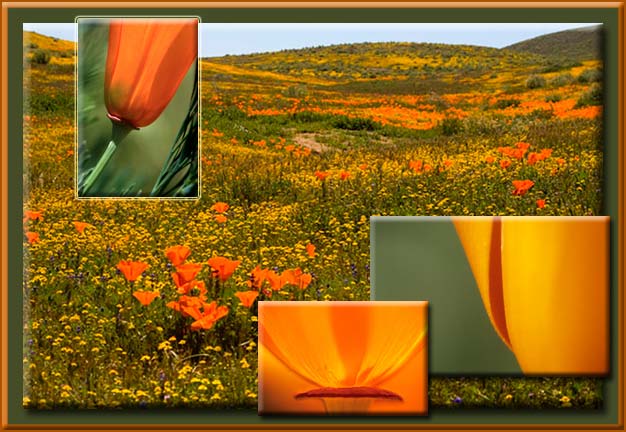
Copyright © Noella Ballenger
When getting started, I like to do an overall shot or two. There is something that attracted my attention and I have to find that and explore it. That will lead me to taking a variety of shots in a variety of ways. Perhaps it will be of a small group of flowers, or a single flower. Perhaps it will be of just the edges of the flower or maybe an abstract. Don’t be shy … take them all!
The Quest and the Discovery
Notice as I’m describing some of these options, I mention playing around or experimenting. Now that we have digital cameras, there isn’t the cost involved with shooting lots of exposures like there was when we used film, so by all means shoot lots of exposures and don’t discard them until you get home and can see them on a large screen. You want to be able to study the string of images that led you to that one photo or group of photos that will reveal exactly what is that you want the viewer to see or feel.
I don’t believe that any art endeavor should be so serious or torturous that we should forget the sense of play. Do I work hard at what I do … you bet … but it is fun. I delight in the exploration, in the quest for a new way, a different way or perhaps a better “old” way to show what I want you to see. Sometimes I get so frustrated that I forget to play … I forget the fun of asking myself, “What happens if I try this or that?” And if what I just tried doesn’t work … well so what! I’ll just try something else. Don’t lose that wonderful sense of freedom you get when you just play.
But what if I have something … some idea stuck in my mind and it doesn’t work and it doesn’t go away. Then what? That might be the time I go for a break or play with the cat or do something entirely different for a little while before I come back and try again. I always try to remember that a long time ago I gave myself permission to fail and not feel badly. Failure is not a weakness, it is strength! When you eliminate one thing that didn’t work, the list becomes shorter and you take a step closer to success.
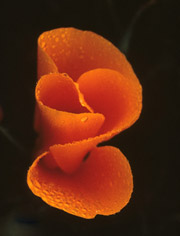
Copyright © Noella Ballenger
Each flower is unique and special. Sometimes it is a color or a line of the petal or perhaps a special shape. This flower reminded me of the lazy 8 symbol that is used to represent infinity on each of our lenses.
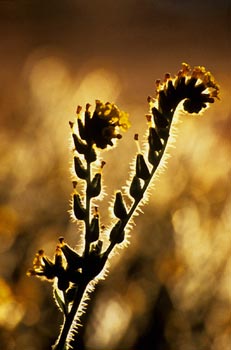
Copyright © Noella Ballenger
Light is so important to photographers, but frequently we don’t explore it or use it to our advantage. This tiny Fiddleneck, of which there are millions and millions in our fields and mountains, can be flat and boring. With a little light magic it can be “stand-alone stunning”! Look for the light, walk around a subject and really look. Watch it … the same one for an hour without moving and watch the light change during that hour. Study and enjoy.
I know that most photographers want the how-to formula for success (what lens, what f-stop, etc …), but that is exactly what I can’t give you. What works for me won’t necessarily work for you. Each one of us is different and that is why I can stand right next to you and describe what shot I am taking and you can do the same and when we finish, we will have two entirely different images.
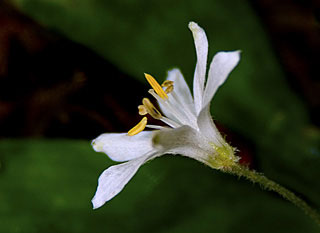
Copyright © Noella Ballenger
In exploring the flower, one of the ways to make it pop away from its background is to allow light on the flower and shadow in the background. Then when you photograph with a lens that is “wide-open” such as at an F2.8 or F4, the background will be blurry and dark and the flower will stand out. Also note that the blur effect will be better if the background is farther away from the flower.
Over the years, I have written a number of “How-to” pieces for Apogee Photo and I hope you will use the Search bar below and look at some of the techniques and expand your repertoire of ideas from which to choose. Make a small card that you can carry with you to remind you of some of the techniques. That will sometimes help you sort it all out. If you don’t know what is possible, you will never push yourself to reaching out for your own creative expression.
Learn to work your camera and lenses and push them to the extreme. If someone tells you that something isn’t meant to do what you are trying to do, then push forward anyway and find out for yourself if it will or won’t work. I remember once that someone told me that you couldn’t stack a tube and a tele-extender together (well maybe a couple of tele-extenders and then a tube) on a lens and have that lens work. Well, yes you can, but the results may be so abstract as to make you shutter (pun intended) …and then again, maybe they will be so abstract that you jump for joy. What I am trying to say here is that you are in charge of the quest, the discovery, the intimacy and the passion. It is all yours and that is what creativity is all about.
by Noella Ballenger

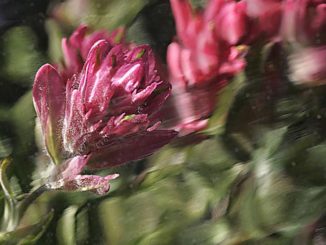
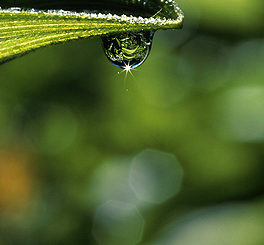
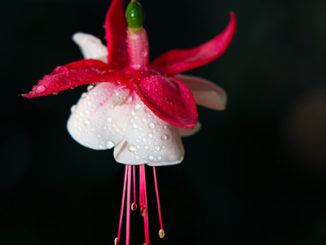
Leave a Reply